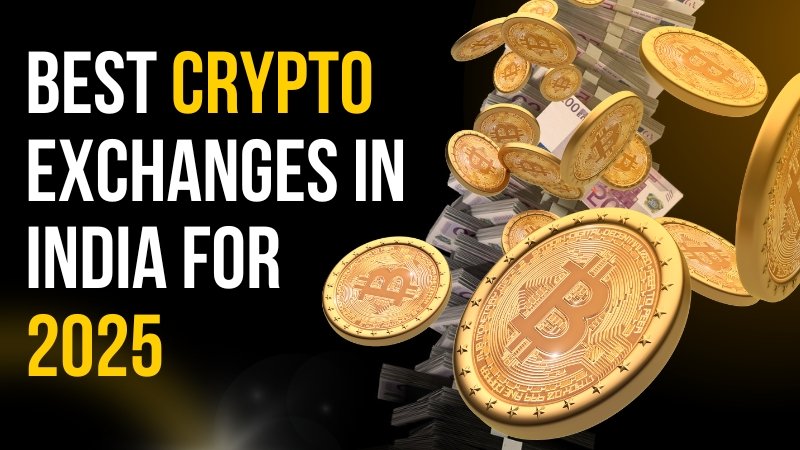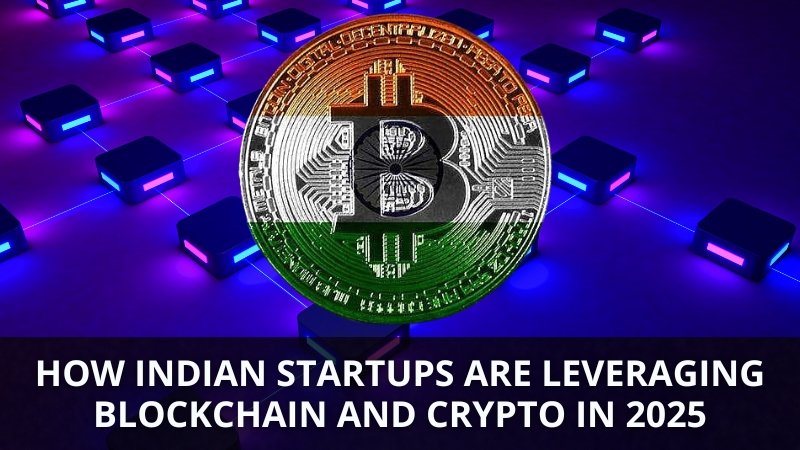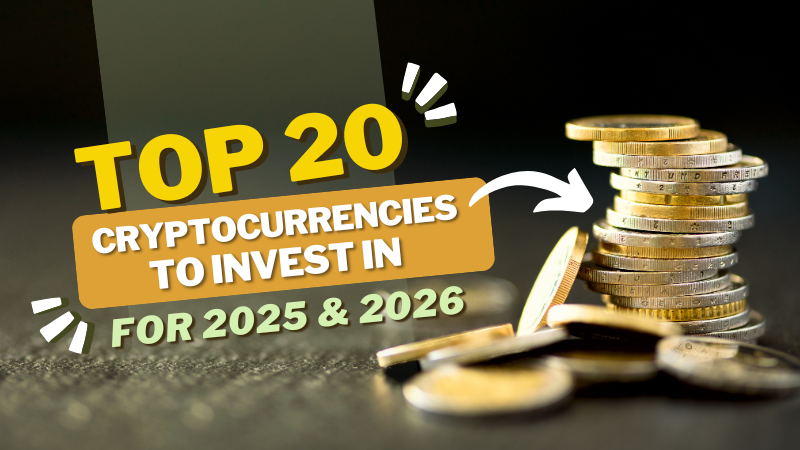
What does crypto actually look like in 2025? Many wonder whether they missed the boat, if Bitcoin and Ethereum have already done what they were going to do and the big gains have come and gone. But the reality is, we may still be in the early phase of something much larger.
Today, the world of crypto has exploded far beyond just Bitcoin and Ethereum. Agreed, they’re still the base and the most trusted building blocks, but the most excitement and innovation is taking place around them. From AI-staked tokens to real-world assets, meme coins with real-world use cases, and newer blockchains like Solana and Sui — the space moves fast. Even traditional finance is slowly starting to pay attention, as developers build faster than ever.
That said, you don’t need to chase interest or be an expert to benefit from what’s coming next. You do need to know where the market is going, which coins are worth keeping an eye on, and how to construct a wise portfolio according to your personal objectives and comfort level.
This guide is designed to help you do exactly that — whether you’re just starting out or already deep into crypto.
How We Ranked the Top 20 Cryptocurrencies for 2025 & 2026
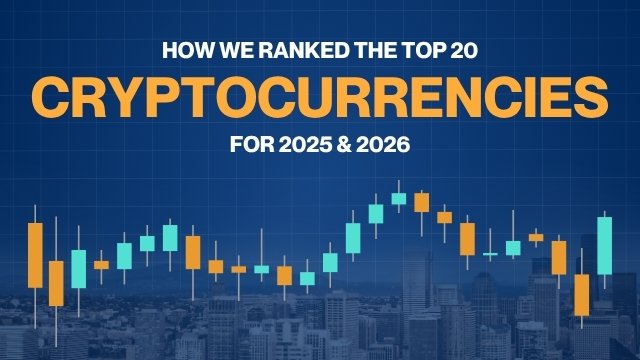
Cryptocurrency markets are moving, and they move fast, which means that changes come quickly as trends develop, narratives form, and yesterday’s hero can be tomorrow’s ghost chain. How do you continue to separate signal from noise in 2025, then? Easy: You take a structured, data-driven approach, and add a human loophole.
Here is the structure we used to analyze and rank, with very high conviction, the top 20 cryptocurrencies for 2025–2026.
The 7 Key Metrics We Used to Evaluate Cryptos
These aren’t just speculative “what-ifs.” We’re looking at hard fundamentals, macro trends, and emerging narratives:
1. Utility & Real-World Use Cases
The #1 question we asked: What problem does this crypto solve in the real world or in the crypto world itself? Memecoins aside (which play a different meta-game), the best assets solve complex problems: finance, AI, gaming, identity, infrastructure, or data.
Example: Chainlink (LINK) provides off-chain data to smart contracts, critical for DeFi, insurance, and tokenized real-world assets.
2. Tokenomics & Supply Design
Not all tokens are built equal. We looked at:
-
Total supply vs. circulating supply
-
Inflation or deflation mechanisms
-
Incentives for holding vs. selling
-
Is the token actually needed for the platform?
Example: ETH’s post-merge deflationary mechanics and staking rewards have made it more attractive for long-term holders.
3. Developer Activity & GitHub Contributions
A strong dev ecosystem is like R&D for crypto. We analyzed:
-
Commits per month
-
Ecosystem growth (dApps, integrations)
-
Grants, hackathons, and L2 support
-
Example: Solana has had one of the fastest-growing ecosystems in terms of NFT, DePIN, and DeFi development.
4. Adoption & Community Growth
Network effects are king. We tracked:
-
Wallet addresses (active vs. total)
-
Transaction volumes and frequency
-
Developer and user communities (Telegram, Discord, GitHub)
-
Social sentiment and global reach
Example: Toncoin (TON), integrated into Telegram with 800M+ users, may onboard more users than any standalone L1 ever could.
5. Institutional Backing & Ecosystem Partners
Who’s backing the project? Is there enterprise or VC confidence? Are big protocols building on it
Example: EigenLayer is attracting capital from both DeFi whales and institutional players — becoming a core pillar of Ethereum’s restaking economy.
6. Narrative Alignment & Trend Positioning
We identified key macro and crypto-native narratives:
-
AI + Crypto
-
DePIN (Decentralized Physical Infrastructure)
-
Restaking & Modular Chains
-
Real-World Assets (RWAs)
-
Decentralized Finance 3.0
-
Meme 2.0 (community > fundamentals)
Example: Render (RNDR) is at the intersection of decentralized GPU rendering, AI, and creative content — 3 booming markets.
7. Future Roadmap & Milestone Execution
We didn’t just trust hype — we followed execution:
-
What milestones were promised vs. delivered?
-
Upcoming testnets, mainnet launches, or upgrades
-
Regulatory readiness (especially in U.S., EU, Asia)
Example: Celestia’s modular architecture and rollup-as-a-service offering has actually launched — it’s not just a whitepaper dream.
2021 vs. 2025: What’s Changed in the Crypto Landscape?
| Factor | 2021 | 2025 |
|---|---|---|
| Narrative | NFTs, Yield Farming, L1 Wars | AI, Modular Chains, Real Yield, RWAs |
| Retail Sentiment | Euphoric, FOMO-driven | Cautious, smarter money with AI tooling |
| Regulatory Landscape | Mostly Wild West | Maturing globally, SEC crackdowns in U.S. |
| User Tools | MetaMask, Coinbase | Zapper, DeFiLlama, EigenLayer dashboards |
| Smart Money Behavior | Chasing memecoins | Value-based allocation + narrative plays |
In other words — the game has evolved. Investors are smarter, tools are sharper, and the market is more efficient. You can’t just throw darts anymore. You need a thesis.
1. Bitcoin (BTC):

Bitcoin remains the undisputed reserve asset of the crypto world. But in a world of AI, DeFi, and ultra-fast smart contract platforms — is that still enough?
What Bitcoin Is — And Why It Still Matters
Launched in 2009, Bitcoin wasn’t just the first cryptocurrency — it was the invention of decentralized money itself. With no central authority, no controlling company, and a strictly capped supply of 21 million coins, Bitcoin introduced digital scarcity to the internet.
Even in 2025, Bitcoin is still viewed as “digital gold” — a hedge against inflation, government overreach, and fiat instability. Its reputation has only been strengthened by:
-
Adoption by major hedge funds (BlackRock, Fidelity, ARK Invest)
-
Integration into global payment apps (Cash App, PayPal, Strike)
-
Legal adoption in countries like El Salvador and potentially others
-
Institutional ETFs (Bitcoin spot ETFs were approved in 2024 in the U.S.)
Quick Stats (As of July 2025)
| Metric | Value |
|---|---|
| Price | ~$66,000 |
| Market Cap | ~$1.3 Trillion |
| Circulating Supply | ~19.7 Million BTC |
| Inflation Rate | ~0.85% (post-2024 halving) |
| Hashrate | ATH – >600 EH/s |
| Layer 2 Ecosystem | Lightning Network, Stacks |
| Institutional Holdings | Over 5% of BTC supply (est.) |
Investment Thesis: Why BTC Still Belongs in Your Portfolio
Despite lacking native smart contracts or flashy dApps, Bitcoin remains the most secure, battle-tested, and censorship-resistant asset in crypto. Here’s why it still matters in 2025:
1. Security First
No chain has greater proof-of-work security than Bitcoin. Its decentralization is second to none.
2. Global Liquidity & Institutional Trust
Bitcoin has the most liquid markets, from CME futures to Grayscale to spot ETFs. Institutions don’t just trust BTC — they now hold it.
3. The First Crypto in Pension Funds
Post-ETF approval, retirement accounts in the U.S., Germany, and Singapore are now allocating to BTC as an “alternative asset”. That’s a game-changer.
4. Layer 2 Growth
While Bitcoin lacks native smart contracts, it’s evolving. Protocols like:
-
Stacks (STX) — bring smart contracts to Bitcoin
-
Lightning Network — enables ultra-fast microtransactions
-
BitVM (experimental) — aims to allow verifiable computing on BTC without changing the base layer
5. Institutional Narrative is Stronger Than Ever
-
“Digital gold” narrative has solidified post-2022 macro volatility
-
ESG concerns around mining are being mitigated via green mining initiatives
-
Top asset managers (BlackRock, VanEck) are actively promoting BTC allocations
Risks to Consider
-
Limited Utility: Bitcoin isn’t a smart contract platform. It won’t power DeFi or AI dApps natively (though STX and others are trying).
-
Volatility: While it’s more stable than altcoins, BTC is still highly volatile by traditional finance standards.
-
Regulation: Governments may increasingly tax, surveil, or restrict BTC usage — particularly around privacy and self-custody.
2025–2026 Outlook: Still a Buy?
Yes — but it depends on your goals.
| Profile Type | Allocation to BTC | Why |
|---|---|---|
| Conservative | 40–60% | Security, liquidity, brand |
| Balanced | 25–35% | Anchor for riskier plays |
| Aggressive / AI degen | 10–15% | Just enough exposure |
If you’re building a crypto portfolio in 2025, not holding any BTC is like investing in tech and ignoring the internet. It may not be where the biggest gains come from, but it’s where the foundation of trust and liquidity lies.
2. Ethereum (ETH):

Ethereum has evolved — it’s more scalable, eco-friendly, and battle-tested than ever. But with stiff competition from Solana, Sui, and modular chains, can it stay #1 in the smart contract arena?
What Is Ethereum — And Why It’s Still Relevant in 2025
Launched in 2015 by Vitalik Buterin and others, Ethereum introduced programmable money to the blockchain world — ushering in an era of:
-
Decentralized finance (DeFi)
-
NFTs
-
DAOs
-
On-chain games and social apps
Ethereum’s post-merge evolution (the 2022 shift to Proof-of-Stake) and subsequent upgrades have made it cleaner, more scalable, and deflationary — a major leap from its early gas-heavy days.
In 2025, it remains the most developed and secure smart contract platform, anchoring hundreds of L2s and tens of thousands of dApps.
Quick Stats (As of July 2025)
| Metric | Value |
|---|---|
| Price | ~$3,900 |
| Market Cap | ~$470 Billion |
| Circulating Supply | ~120.1 Million ETH |
| Inflation Rate | -0.2% (deflationary post-merge) |
| Daily Transactions | 1.2M+ on L1, 4M+ on L2s |
| Staked ETH | 33M ETH (~27% of supply) |
| L2 Ecosystem | Arbitrum, Optimism, Base, zkSync |
| Top DApps | Aave, Uniswap, EigenLayer, Lido |
Key Upgrades & Milestones Since 2023
- The Merge (2022) → PoW to PoS
- Shanghai Upgrade (2023) → ETH unstaking enabled
- EIP-4844 (Proto-Danksharding, 2024) → L2 scaling boost
Rollup-Centric Future (2025) → Ethereum becomes a settlement layer, not just a smart contract chainEthereum is no longer trying to compete on speed or gas fees. That’s what L2s are for. It’s now the decentralized root of trust.
Why ETH Remains a Top Investment in 2025–2026
1. Real Yield + Staking
ETH is deflationary due to EIP-1559’s burn mechanism and pays native yield (~3–4%) to stakers. It’s crypto’s first “bond-like” asset.
2. Massive Developer Base
Ethereum still leads in:
-
Developer activity
-
Tooling (Hardhat, Foundry, Solidity)
-
Hackathons, grants, and GitHub commits
3. L2 Explosion = More ETH Demand
Every rollup (Arbitrum, Base, zkSync, etc.) settles back to Ethereum, increasing L1 demand while reducing retail gas costs.
4. EigenLayer + Restaking Narrative
Ethereum’s economic security is now monetizable via restaking — powering middleware like oracles, bridges, and AI verifiers. EigenLayer alone is driving billions in TVL.
5. Institutional Traction
While Bitcoin ETFs stole headlines, ETH ETFs are next — with futures products already live and spot ETF applications pending.
What Are the Risks?
-
L2 Fragmentation: Too many rollups may lead to a fragmented UX.
-
Competition from Alt-L1s: Solana, Sui, and modular L1s (like Celestia) offer faster and cheaper alternatives.
-
Regulatory Gray Zone: ETH’s status as a commodity or security remains unclear in some jurisdictions.
2025–2026 Outlook: Still a Blue-Chip Buy?
| Investor Type | Allocation to ETH | Why |
|---|---|---|
| Institutional | 20–40% | Liquid, stakable, deflationary |
| DeFi-Native | 30–50% | Collateral, governance, gas |
| Retail Beginner | 15–30% | Strong upside, ecosystem exposure |
3. Solana (SOL):

Solana has evolved from an “ETH killer” meme into one of the most performant, rapidly growing, and community-driven ecosystems in crypto. In 2025, it’s not just fast — it’s a cultural phenomenon.
What Is Solana — and Why It’s Booming in 2025
Launched in 2020, Solana is a high-speed Layer 1 blockchain that uses Proof of History (PoH) and Turbine to process thousands of transactions per second — without the need for rollups or sharding.
While it suffered major setbacks during the 2022–2023 bear market (including deep exposure to FTX), Solana made a dramatic turnaround in 2024–2025 by focusing on:
-
Performance & simplicity (one global state, no fragmented rollups)
-
Cultural virality (memecoins, NFTs, DePIN, and Telegram bots)
-
Retail UX (mobile-first with Solana Mobile + xNFTs)
Quick Stats (As of July 2025)
| Metric | Value |
|---|---|
| Price | ~$175 |
| Market Cap | ~$80 Billion |
| TPS (Real-world) | 800–2,000+ |
| Transaction Costs | ~$0.0002 |
| Ecosystem Wallets | Phantom, Backpack |
| Key dApps | Jupiter, Tensor, MarginFi, Helium, Dialect |
| Dev Activity | Top 3 among all chains |
The Solana Ecosystem Renaissance
1. DePIN & Real-World Infrastructure
Projects like Helium and Hivemapper are building decentralized physical networks on Solana — powering real-world value and data.
2. Meme Culture & Retail Onboarding
Memecoins like Bonk, WIF (dogwifhat), and Popcat exploded — not just in price, but in user onboarding. Solana’s community embraced memes without apology, bringing normies on-chain.
3. Smart AI Agents & Bots
Telegram-integrated DeFi bots (like Jito, Kamino, and Sharky) have made DeFi social, mobile, and automated, especially among Gen Z traders.
4. Solana Mobile 2.0
The Saga phone was memed to death in 2023… until it wasn’t. In 2025, Solana Mobile 2.0 includes:
-
Embedded seed vaults
-
NFT-native operating layers (xNFTs)
-
Integrated DEXes and Web3 messaging
Solana is building for the mobile-native future — something no other major chain is seriously prioritizing.
What Makes Solana a Strong 2025–2026 Investment?
-
Unmatched Speed & UX: It’s the only chain offering near-CeFi performance natively on-chain.
-
Low Fees at Scale: Solana hasn’t needed L2s — it just scales.
-
Vibrant Ecosystem: New protocols launch almost daily. Airdrops, memes, and open developer grants are everywhere.
-
Retail Favorite: If Ethereum is Wall Street, Solana is TikTok.
Risks to Consider
-
Validator Centralization: Solana is fast, but critics point to relatively high hardware requirements.
-
Outages (Improved): While stability has improved, any downtime still affects confidence.
-
Lack of Modularity: No L2 ecosystem means monolithic scaling — which can limit flexibility long-term.
2025–2026 Outlook: Ethereum’s Biggest Challenger?
| Profile Type | Allocation to SOL | Why |
|---|---|---|
| Growth Seeker | 20–30% | Speed, upside, culture |
| Gen Z / Meme Traders | 30–50% | Mobile-native, bot culture, NFTs |
| Balanced Portfolio | 10–20% | High-upside L1, hedge to ETH |
Solana is no longer the “Ethereum killer.” It’s built its own distinct empire — fast, cheap, cultural, and increasingly sticky. If Ethereum becomes the trust layer of crypto, Solana may become its user layer.
4. Chainlink (LINK):

Chainlink is the invisible engine behind DeFi, tokenized real-world assets (RWAs), insurance, gaming, and more. In 2025, it’s become the trusted bridge between blockchains and reality.
What Is Chainlink — and Why It Matters More Than Ever
Launched in 2017, Chainlink is a decentralized oracle network — meaning it delivers off-chain data (like asset prices, weather, sports results, credit scores, etc.) to smart contracts in a secure, tamper-proof way.
In simple terms: blockchains are closed systems, and Chainlink is how they connect to the outside world.
By 2025, Chainlink has evolved from just a price feed provider to a data interoperability and compute layer for the entire Web3 stack.
Quick Stats (As of July 2025)
| Metric | Value |
|---|---|
| Price | ~$18.50 |
| Market Cap | ~$10.5 Billion |
| Active Integrations | 2,200+ protocols |
| Daily Oracle Calls | 10M+ |
| Real-World Use Cases | Finance, Gaming, Insurance, AI |
| New Primitives | CCIP, DECO, Functions, Data Streams |
| TVS (Total Value Secured) | $100B+ |
2025 Game-Changers for Chainlink
1. CCIP (Cross-Chain Interoperability Protocol)
Chainlink’s CCIP lets smart contracts across different chains talk to each other securely. Think of it as the TCP/IP of blockchains.
Used by Swift, DTCC, and top banks to move tokenized assets across private and public chains.
2. Real-World Assets (RWAs)
Chainlink is the go-to oracle for tokenized treasuries, bonds, and real estate. As RWAs go mainstream, LINK becomes the infrastructure layer.
3. DECO (Privacy-Preserving Oracles)
Using zero-knowledge proofs, DECO enables oracles to verify sensitive off-chain data without revealing it — ideal for credit scoring, health records, or identity verification.
4. AI + Chainlink Functions
With Chainlink Functions, developers can now connect AI agents, APIs, and IoT devices directly to smart contracts. Use cases include:
-
Weather-based insurance payouts
-
Real-time sports betting
-
AI-generated DeFi automation
Why LINK Deserves a Spot in Every Portfolio
-
Network Effects: Chainlink secures more value than any other oracle — by far.
-
Institutional Adoption: Collaborations with Swift, Google Cloud, DTCC, and dozens of TradFi giants.
-
Utility Demand for LINK Token: LINK is used for:
-
Paying for data services
-
Staking
-
Providing security guarantees for CCIP
-
Staking 2.0 Is Live
Stakers earn real yield based on the volume and reliability of data services they provide. It’s not just passive — it’s performance-based.
Risks to Watch
-
Oracle Competition: Projects like Pyth and Band Protocol offer similar services, but have far less traction.
-
Complex Tokenomics: LINK demand depends on protocol growth, which some investors find harder to model than L1s.
-
Retail Awareness Gap: LINK isn’t as “sexy” as SOL or ETH — which limits hype-driven growth.
2025–2026 Outlook: The Intel of Crypto?
| Profile Type | Allocation to LINK | Why |
|---|---|---|
| RWA Believers | 10–20% | Link bridges TradFi + crypto |
| DeFi Enthusiasts | 5–15% | Mission-critical infrastructure |
| Long-Term Holders | 10–25% | Low hype, high conviction asset |
Chainlink isn’t trying to be flashy. It’s trying to connect blockchains to the real world — securely, verifiably, and at scale. As crypto eats traditional finance, Chainlink will feed it the data it needs to survive.
5. Polygon (MATIC):

Polygon was once the go-to Ethereum scaling solution. But in 2025, with rollups dominating and modular blockchains rising, is it still a key piece of Web3 infrastructure — or just another Layer 2?
What Is Polygon — and Where It Stands in 2025
Polygon started as a sidechain for Ethereum — helping scale congested dApps like DeFi and NFTs back in 2021. But since then, it’s transformed into a full-blown ecosystem of scaling solutions, including:
-
PoS Chain (still active)
-
zkEVM (zero-knowledge Layer 2 rollup)
-
Polygon CDK (Custom chain development kit)
-
AggLayer (interoperability protocol between L2s)
Polygon isn’t just “a chain” anymore — it’s a decentralized infrastructure brand.
Quick Stats (As of July 2025)
| Metric | Value |
|---|---|
| Price | ~$0.90 |
| Market Cap | ~$8.1 Billion |
| TVL (Total Value Locked) | ~$2.7 Billion |
| Daily Active Wallets | 700K+ |
| Key Products | Polygon zkEVM, CDK, AggLayer |
| Major Partnerships | Disney, Starbucks, Flipkart, Nubank |
| L2 Tech Type | zk-Rollup, PoS Chain |
2025: Polygon’s Shift From Sidechain to Infra Layer
1. zkEVM & zkRollup Strategy
Polygon launched one of the first fully EVM-compatible zk-rollups, making it easy for devs to port over Ethereum apps with zero code changes. Faster, cheaper, more secure — and dev-friendly.
2. CDK: The “WordPress for Chains”
Polygon CDK allows builders to launch their own L2 chains with plug-and-play modules — all powered by zk tech and Ethereum settlement.
Think of CDK as the “Shopify of blockchains” — it empowers customized, interoperable ecosystems.
3. AggLayer: Connecting the Dots
Polygon’s AggLayer acts as a coordination protocol for cross-chain liquidity and UX — solving fragmentation issues plaguing Ethereum’s rollup-centric roadmap.
4. Real-World Adoption
Polygon is leading the enterprise + consumer adoption front:
-
Tokenized loyalty programs (Starbucks Odyssey)
-
NFTs and payments (Reddit, Mastercard)
-
Government projects in India and Latin America
-
Neobank partnerships with Nubank and Grab
Investment Case for MATIC in 2025
-
Strong Brand & Dev Mindshare: Even newer devs know Polygon — it’s often their first step into Ethereum scaling.
-
zk Narrative Exposure: Zero-knowledge proofs are one of the biggest tech waves in crypto — and Polygon’s early bet is paying off.
-
Enterprise Traction: No other chain has integrated with as many household names.
Risks to Consider
-
L2 Competition: Arbitrum, Optimism, zkSync, and Base are fighting for the same turf — some with better performance or economics.
-
Too Many Chains, Not Enough Users? Fragmentation of products and branding may confuse users and dilute MATIC demand.
-
Token Utility Unclear in zk World: With Polygon shifting to many chains and CDKs, how MATIC accrues value remains a hot topic.
2025–2026 Outlook: Still a Key Piece of the Scaling Puzzle?
| Profile Type | Allocation to MATIC | Why |
|---|---|---|
| Ethereum Builders | 10–15% | Deep EVM integration + zk power |
| Long-Term Scalability Investors | 5–10% | Bet on the modular + infra stack |
| Enterprise Exposure | 5–15% | Consumer and big-brand traction |
Polygon is no longer just an L2 — it’s building a full-stack, enterprise-ready Ethereum scaling ecosystem. While competition is intense, its zk strategy and brand relationships give it a unique edge in the road to mainstream Web3 adoption.
6. Injective (INJ):

Injective isn’t just another Layer 1 — it’s a purpose-built, finance-first blockchain that’s capturing the AI + DeFi narrative. Fast, composable, and deeply integrated with Cosmos and oracles, Injective may be the most underrated high-performance chain of 2025.
What Is Injective?
Injective launched in 2021 as a custom Layer 1 blockchain focused on decentralized finance (DeFi). It’s built using the Cosmos SDK and optimized for high-speed, front-running-resistant trading and synthetic asset creation.
But by 2024–2025, Injective morphed into a high-performance ecosystem with:
-
AI agents trading on-chain
-
Derivatives and real-world assets (RWAs)
-
Oracle-native integrations with Chainlink, Pyth, and Chronicle
-
Customizable modules for builders (using CosmWasm smart contracts)
In a sentence: Injective is where quant finance meets AI meets permissionless trading.
Quick Stats (As of July 2025)
| Metric | Value |
|---|---|
| Price | ~$38.00 |
| Market Cap | ~$3.7 Billion |
| TPS | 10,000+ |
| Finality Time | ~1 second |
| Core Ecosystem Apps | Helix, DojoSwap, Mito, Astroport |
| Oracle Integrations | Chainlink, Pyth, Band, Chronicle |
| AI Narrative Exposure | High — native modules + partnerships |
| Interoperability | Cosmos IBC + Ethereum Bridges |
2025 Catalysts That Put Injective on the Map
1. AI x On-Chain Agents
Injective is one of the first chains actively hosting autonomous trading bots powered by AI, thanks to:
-
Permissionless logic execution (CosmWasm)
-
Data-rich oracle feeds (sub-second latency)
-
Near-zero fees and finality under 1 second
Imagine AI bots interacting with DeFi directly — no exchange middlemen.
2. App-Specific Modular Ecosystem
Injective is building custom DeFi apps natively — like:
-
Mito: Yield strategy protocol for RWAs and stablecoins
-
Helix: Cross-chain perpetual DEX
-
DojoSwap: Fastest spot DEX on Cosmos
3. Interchain Liquidity
Thanks to IBC (Inter-Blockchain Communication), Injective is deeply connected with:
-
Cosmos
-
Osmosis
-
Kujira
-
Ethereum (via bridges)
Injective brings CEX-like performance to DeFi without compromising decentralization — and now with AI automation.
Why INJ Is a Strong 2025–2026 Investment
-
Natively Designed for Finance: Unlike general-purpose L1s, Injective is tailor-made for trading and derivatives.
-
AI-Ready Infrastructure: High speed + rich data = perfect playground for AI models to interact with markets.
-
Revenue-Generating: Protocol-level buy-and-burn mechanism, based on dApp fees, gives INJ deflationary pressure + real yield.
-
Cosmos-Aligned: Cross-chain composability is becoming a major narrative — and Injective is plugged in by default.
What to Watch Out For
-
Not a Household Name (Yet): Lower retail mindshare compared to Solana or Arbitrum.
-
Complexity: Financially sophisticated protocols = higher user learning curve.
-
AI Narrative Bubble Risk: Some of the AI + DeFi hype may outpace current use case depth.
2025–2026 Outlook: The Bloomberg Terminal of Web3?
| Investor Profile | Allocation to INJ | Why |
|---|---|---|
| DeFi Power Users | 10–20% | Native perps, yield, and oracles |
| AI x Crypto Believers | 15–25% | Direct AI agent integrations |
| Cosmos Ecosystem Players | 10–15% | Interchain liquidity and composability |
Injective is no longer under the radar — it’s the chain where AI and on-chain finance collide. If you believe in a future of tokenized everything, self-driving bots, and zero-fee global markets, INJ might be one of your highest-conviction asymmetric bets.
7. Avalanche (AVAX):

Avalanche was once grouped with other L1s fighting for DeFi dominance. In 2025, it’s redefined itself as the infrastructure layer for institutions, RWAs, and custom blockchain ecosystems — thanks to its unique subnet architecture. The question now isn’t “what can Avalanche do,” but “will the market catch up in time?”
What Is Avalanche?
Avalanche is a smart contract platform that launched in 2020, powered by the Avalanche Consensus Protocol — which offers fast finality (~1 second), low fees, and a multi-chain architecture.
Unlike monolithic chains like Ethereum or Solana, Avalanche uses:
-
The C-Chain (EVM-compatible for general smart contracts)
-
The P-Chain (for validator and subnet coordination)
-
The X-Chain (for asset transfers)
Its most distinctive feature? Subnets — essentially custom, application-specific blockchains with tailored rules, validators, and compliance levels.
In 2025, subnets are no longer experimental — they’re powering gaming, RWAs, and even government-regulated digital assets.
Quick Stats (As of July 2025)
| Metric | Value |
|---|---|
| Price | ~$33.00 |
| Market Cap | ~$12.8 Billion |
| TVL (Total Value Locked) | ~$1.4 Billion |
| Subnets Launched | 70+ live |
| Time to Finality | ~1 second |
| Key Protocols | Stars Arena, Dexalot, Struct, Avascan |
| Real-World Adoption | JPMorgan, WisdomTree, Republic |
Why Avalanche Is Heating Up in 2025
1. Institutional Subnets
Big financial players are choosing Avalanche subnets because they offer:
-
KYC/AML compliance
-
Sovereign validator sets
-
Native asset issuance tools
-
Full EVM compatibility
JPMorgan used Avalanche to test on-chain asset settlement; firms like Citi, WisdomTree, and Deloitte are exploring similar paths.
2. Tokenized RWAs (Real-World Assets)
Avalanche subnets are being used to issue:
-
Tokenized stocks
-
Bonds
-
Real estate shares
-
Carbon credits
Protocols like Republic and Intain are building RWA marketplaces with institutional rails.
3. Gaming & Creator Economies
Game developers are launching high-performance subnets to avoid gas congestion and deliver:
-
Near-zero fees
-
Fast UX
-
In-game token economies
Example: Shrapnel, a AAA shooter game, runs on its own Avalanche subnet.
4. Hyper-Scalability via Modularization
Unlike Ethereum’s rollups or Solana’s monolithic model, Avalanche lets each subnet operate in parallel — with custom gas tokens, privacy features, and logic.
Why AVAX Is Still a Strong Bet
-
First-mover advantage in the subnet model
-
Deep relationships with institutions and governments
-
Still early in terms of subnet value accrual and AVAX demand (each subnet must stake AVAX)
-
Ecosystem developer grants remain robust
Key Risks
-
Complexity: Understanding subnets takes time — and may deter casual retail users.
-
Fragmented Liquidity: Subnets silo assets unless bridges or shared liquidity protocols are used.
-
Underappreciated by Retail: Despite serious tech, Avalanche doesn’t generate the same cultural hype as Solana or Ethereum.
2025–2026 Outlook: Infrastructure for the Quiet Billion
| Profile Type | Allocation to AVAX | Why |
|---|---|---|
| RWA & TradFi Enthusiasts | 10–20% | Institutional momentum + subnet design |
| Long-Term Infrastructure Investors | 10–15% | Undervalued scaling and modularization |
| Web3 Gaming Backers | 5–10% | Game-specific chains on custom subnets |
Avalanche may not trend on crypto Twitter every week — but it’s building the compliance-ready, modular backbone of blockchain’s institutional future. If RWAs and permissioned chains win long term, AVAX may be among the biggest beneficiaries.
8. Sui (SUI):

Sui is one of the fastest and most developer-friendly blockchains in the market today — built by ex-Meta engineers using the Move programming language. In 2025, it’s quietly powering the next wave of real-world apps, gaming, commerce, and finance with performance that rivals any existing L1.
What Is Sui?
Sui (pronounced “swee”) is a Layer 1 blockchain launched by Mysten Labs, founded by former engineers who built Meta’s Diem blockchain and Move language infrastructure. It uses a novel object-centric data model and parallel execution engine to deliver:
-
Near-instant finality (~480ms)
-
Ultra-low fees
-
Massive horizontal scalability
-
Powerful developer tools
Unlike Ethereum or Solana, Sui processes transactions based on the relationships between “objects” — which allows it to parallelize execution and avoid bottlenecks.
Think of Sui as Web3’s first cloud-native, object-oriented, high-speed smart contract platform — designed to scale like AWS, not a blockchain.
Quick Stats (As of July 2025)
| Metric | Value |
|---|---|
| Price | ~$1.35 |
| Market Cap | ~$2.3 Billion |
| TPS (Theoretical) | 120,000+ |
| Average Finality | ~480 ms |
| Active Wallets | 3.2M+ |
| Dev Language | Move (modified for Sui) |
| Key Use Cases | DeFi, gaming, digital commerce, NFTs |
| Top dApps | Cetus, Typus, Scallop, Kriya, MovEx |
2025 Catalysts for Sui’s Growth
1. Parallel Execution = Real-World Performance
Most blockchains process transactions sequentially. Sui’s execution engine enables simultaneous transaction processing, making it ideal for:
-
High-frequency trading
-
Gaming (real-time state changes)
-
Social and retail apps with high throughput
2. Developer-Centric Toolkit
-
Move language is safer and more modular than Solidity.
-
Built-in upgradeability and versioning tools.
-
Object-centric programming makes tokenization of complex assets (e.g. game items, deeds, collectibles) seamless.
Sui is where Web3 meets software engineering best practices.
3. Gaming, SocialFi & Commerce Apps
Sui has rapidly become a home for on-chain:
-
Game economies (e.g., Aftermath, Abyss World)
-
NFT marketplaces
-
Social finance platforms with tokenized influence
-
Loyalty programs and micro-commerce
It’s one of the few L1s actively shipping apps with real UI/UX polish — many of them indistinguishable from Web2.
4. Real-World Expansion
2025 has seen:
-
Sui-based loyalty programs from APAC consumer brands
-
Early tokenized supply chain pilots in SEA and MENA
-
Partnerships with fintech and point-of-sale (POS) companies in Asia
Why SUI Is a Strong Play for 2025–2026
-
Incredible speed and UX — perfect for real-world scale
-
Strong VC and ecosystem backing (a16z, Mysten Labs)
-
First-mover advantage in Move-based execution
-
Still underpriced relative to tech maturity and growth trajectory
-
Developer growth remains exponential month over month
Risks to Watch
-
Not EVM-compatible: Requires devs to learn Move
-
Still early in user/institutional mindshare
-
Competing with Aptos (also Move-based) for a similar narrative
-
Unclear regulatory posture in Western markets
2025–2026 Outlook: A Developer’s Dream Chain?
| Investor Profile | Allocation to SUI | Why |
|---|---|---|
| Builder / Technical Investor | 10–20% | Cutting-edge architecture, object model |
| Gaming & Commerce Bulls | 10–15% | Native support for high-speed dApps |
| High-Risk Growth Portfolios | 5–10% | Asymmetric upside from early-stage L1 |
Sui isn’t just a fast chain — it’s an entirely new model for how Web3 apps can be built, scaled, and upgraded. If you missed early Solana or Avalanche, Sui might be your second shot at backing a truly next-gen L1 from the ground up.
9. Celestia (TIA):

Celestia isn’t a smart contract platform in the traditional sense — it’s the infrastructure beneath them. As the first true modular blockchain, Celestia enables a future where chains are composable, interoperable, and infinitely scalable. In 2025, it’s becoming the bedrock of a multi-chain world.
What Is Celestia?
Launched in late 2023, Celestia is a modular blockchain that specializes in one crucial job: data availability (DA). In other words, it provides the infrastructure that allows other blockchains — called rollups — to publish their data and prove their transactions to the world.
Instead of one chain trying to do everything (execution, consensus, settlement), modular chains like Celestia separate those duties. This enables:
-
Faster scaling
-
Better specialization
-
Independent execution environments
Think of Celestia as the “cloud layer” for rollups. It does for blockchains what AWS did for websites.
Quick Stats (As of July 2025)
| Metric | Value |
|---|---|
| Price | ~$10.25 |
| Market Cap | ~$1.7 Billion |
| TPS (DA-focused) | 15,000+ |
| Rollups Secured | 120+ (Celestiums, Sovereign Rollups) |
| Key Users | Eclipse, Dymension, Manta, Saga |
| Focus | Data availability + modular scaling |
Why Celestia Is Gaining Traction in 2025
1. Modular Blockchain Movement
Ethereum is embracing rollups (Optimism, Arbitrum, Base), but Celestia takes it further — enabling anyone to spin up their own sovereign chain (or rollup) with:
-
No need for their own validator set
-
Low cost, decentralized data publication
-
Custom execution logic and VMs
The result? Thousands of chains — all secured by Celestia.
2. Rollup-as-a-Service (RaaS)
Developers can now deploy their own appchains in minutes using frameworks like:
-
Sovereign SDK
-
Rollkit
-
Eclipse (Solana VM rollups on Celestia)
-
Dymension (modular appchains with shared liquidity)
Celestia’s vision is “one chain per application” — without sacrificing security or decentralization.
3. Real Use Cases Emerging
-
DePIN protocols launching custom rollups
-
Privacy-preserving zk rollups for compliance use
-
NFT games and metaverses spinning out their own execution layers
Why TIA Is an Asymmetric Bet
-
Pure-play on the “modular future” of crypto
-
Real-world developer traction with dozens of live rollups
-
TIA used for data publishing fees and staking (securing DA layer)
-
Critical infrastructure for upcoming rollup-heavy ecosystems like zkSync, Manta, and Saga
Risks to Consider
-
Highly technical value proposition (not intuitive for retail)
-
Still early in revenue accrual (most rollups are subsidized)
-
New competition emerging from Avail, EigenDA, Near DA
-
Value capture depends on modular ecosystem growth — not just TIA
2025–2026 Outlook: The AWS of Web3?
| Profile Type | Allocation to TIA | Why |
|---|---|---|
| Infra/Scaling Investors | 10–20% | Modular thesis, exponential upside |
| Rollup Ecosystem Builders | 5–15% | Backbone for custom execution |
| Visionary Crypto Natives | 10–25% | Long-term play on Web3’s architecture |
Celestia isn’t trying to win the L1 wars — it’s trying to end them. By abstracting away consensus and letting developers launch their own custom chains, TIA positions itself as the critical layer for a truly modular, multi-chain future. If this narrative plays out, it could be as foundational as Ethereum itself.
10. Arbitrum (ARB):

Arbitrum has quietly become the most adopted Ethereum Layer 2 in terms of total value locked (TVL), users, and dApp activity. With Nitro, Orbit, and Stylus all live in 2025, Arbitrum is no longer just a rollup — it’s a full ecosystem that may outgrow its parent chain.
What Is Arbitrum?
Arbitrum is an optimistic rollup that scales Ethereum by processing transactions off-chain, then submitting proofs back to Ethereum for final settlement. But unlike basic rollups, Arbitrum has evolved into a rich Layer 2 framework featuring:
-
Arbitrum One (flagship optimistic rollup)
-
Arbitrum Nova (for gaming and social dApps)
-
Arbitrum Orbit (custom rollups as a service)
-
Stylus (EVM+WASM support for high-performance contracts)
Its parent company, Offchain Labs, continues to ship upgrades that make Arbitrum more efficient, customizable, and cost-effective.
Arbitrum is no longer “just a rollup.” It’s a thriving L2 ecosystem building its own appchains and developer toolkits.
Quick Stats (As of July 2025)
| Metric | Value |
|---|---|
| Price (ARB) | ~$1.38 |
| Market Cap | ~$3.5 Billion |
| TVL (Total Value Locked) | $14.2 Billion |
| Active dApps | 500+ |
| Daily Transactions | 2.8M+ |
| Orbit Chains Launched | 110+ |
| Dev Tooling | Stylus, Nitro, Orbit, BOLD |
2025 Highlights: Why Arbitrum Is Surging
1. Orbit: Custom Chains Built on Arbitrum Stack
Orbit enables developers to launch their own L3 or L2 rollups using Arbitrum tech — either as part of Arbitrum One/Nova or on their own settlement layers. All Orbit chains share:
-
Interoperability
-
Tooling compatibility
-
Settlement optionality (Ethereum or others)
Orbit chains are like SaaS platforms for sovereign dApps — faster, cheaper, and native to Ethereum security.
2. Stylus: Unlocking the EVM Bottleneck
Stylus allows developers to write smart contracts in Rust, C, and C++, not just Solidity — while achieving 10x+ lower gas costs and better performance.
This is a massive upgrade that opens Ethereum-like development to Web2 programmers and high-performance use cases (e.g. machine learning, financial computing).
3. Network Effects at Scale
-
Airdrop meta: Projects like GMX, Radiant, and Premia bootstrapped user bases on Arbitrum
-
Massive ecosystem funds (>$200M) are still being distributed
-
Bridges, stablecoins, and CEX support are fully matured
Why ARB Still Has Room to Grow
-
Still undervalued vs. ecosystem size and dominance
-
Governance DAO (Arbitrum DAO) is one of the largest in crypto
-
Revenue sharing and sequencer fee capture being rolled out
-
Core rollup infra for 2025’s biggest Ethereum-native launches
Key Risks to Watch
-
Sequencer still centralized (decentralization roadmap in progress)
-
Governance process is active, but complex and under scrutiny
-
Competition from other L2s (Optimism, Base, zkSync, etc.)
-
No clear native token utility for Orbit chains yet
2025–2026 Outlook: Ethereum’s Expansion Engine?
| Profile Type | Allocation to ARB | Why |
|---|---|---|
| ETH Scaling Advocates | 10–20% | Arbitrum is core to Ethereum’s roadmap |
| L2 Ecosystem Builders | 5–15% | Orbit and Stylus open up new possibilities |
| Airdrop Meta / DeFi Users | 10–25% | Rich dApp and yield farming ecosystem |
Arbitrum is now more than just Ethereum’s most popular rollup — it’s a launchpad for modular chains, advanced dApps, and new development paradigms. As Ethereum’s scaling narrative matures, Arbitrum could be the most valuable L2 in the stack — both technically and economically.
11. Optimism (OP):

Optimism is more than a Layer 2 rollup — it’s pioneering a new paradigm called the Superchain: a network of interoperable, Ethereum-aligned rollups. With deep integration into Coinbase, powerful governance, and the upcoming revenue-sharing model via RetroPGF, Optimism is emerging as one of the most influential forces in Ethereum’s future.
What Is Optimism?
Optimism is an optimistic rollup — meaning it executes transactions off-chain and posts transaction data and fraud proofs to Ethereum L1. It was one of the first Ethereum L2s to launch and has evolved into a movement with the following components:
-
Optimism Mainnet (the flagship L2)
-
OP Stack: the modular rollup development framework
-
Superchain: a mesh of chains built with the OP Stack
-
Retroactive Public Goods Funding (RetroPGF): a revolutionary way to reward contributors
Optimism isn’t just scaling Ethereum — it’s re-architecting the way we fund and govern the open internet.
Quick Stats (As of July 2025)
| Metric | Value |
|---|---|
| Price (OP) | ~$2.10 |
| Market Cap | ~$5.6 Billion |
| TVL (Total Value Locked) | ~$8.4 Billion |
| Ecosystem Chains | 60+ OP Stack Chains (incl. Base) |
| Daily Transactions | 2.1M+ |
| Dev Tooling | OP Stack, Bedrock, RetroPGF |
| Key dApps | Velodrome, Sonne, Kandel, Worldcoin, Base-native DeFi |
What Makes Optimism Unique in 2025
1. Superchain Vision
The Superchain is a horizontally scalable network of rollups that share:
-
A common framework (OP Stack)
-
Unified governance (via the Optimism Collective)
-
Interoperability and atomic composability
Chains like Base (by Coinbase), Mode, and Zora all use the OP Stack and are actively participating in the Superchain thesis.
2. RetroPGF (Retroactive Public Goods Funding)
Instead of funding projects upfront, Optimism allocates governance-controlled OP tokens to projects that have already demonstrated positive impact.
-
$100M+ distributed to builders, designers, writers, and infrastructure teams
-
Sets a precedent for sustainable, decentralized ecosystem funding
3. Deep Institutional Integration
-
Base chain (Coinbase’s L2) is built on the OP Stack
-
Near-zero fees, strong fiat onramps, and broad distribution
-
Optimism is becoming the consumer-facing L2 infrastructure of choice
4. OP Stack Flexibility
Builders can fork or build on the OP Stack to launch custom rollups with their own gas tokens, governance, and parameters — while staying Ethereum-aligned.
Why OP Is One of the Most Strategic Tokens in 2025
-
Ecosystem growth = value accrual back to OP token holders
-
Governance rights over RetroPGF and protocol upgrades
-
Sequencer fee sharing across Superchain
-
High-quality dev base and public goods culture
Risks to Watch
-
Token utility still under refinement (sequencer fee share not fully deployed)
-
Governance complexity — RetroPGF outcomes can be controversial
-
Fierce competition from Arbitrum, zkSync, and Base (despite shared tech)
-
Superchain value capture may remain fragmented across many tokens
2025–2026 Outlook: Ethereum’s Civic Infrastructure?
| Profile Type | Allocation to OP | Why |
|---|---|---|
| Ethereum-Aligned Builders | 10–25% | OP Stack and Superchain thesis |
| Governance Token Collectors | 5–15% | Strong voting power and RetroPGF influence |
| Public Goods Advocates | 10–20% | Ethical + economic play on ecosystem health |
Optimism isn’t just scaling Ethereum — it’s building a new form of economic democracy. Between its role in Coinbase’s Base chain, public goods funding, and developer alignment, OP may become the L2 token with the most narrative, usage, and institutional buy-in in the years to come.
12. Toncoin (TON):

TON is the native token of The Open Network — a fast, scalable blockchain originally designed by Telegram and now integrated directly into the messaging app’s ecosystem. In 2025, TON is onboarding millions of new users via mini-apps, P2P payments, and memecoin mania. It’s not just a chain — it’s crypto’s best shot at mainstream adoption.
What Is Toncoin?
TON (The Open Network) is a Layer 1 blockchain that emphasizes performance, simplicity, and consumer-facing UX. Originally developed by Telegram in 2018 as “Telegram Open Network,” it faced regulatory setbacks and was spun off to the open-source community in 2020. But Telegram never fully let go — and in 2023–2025, the app leaned into TON hard.
Key features include:
-
Native integration in Telegram’s UI
-
Blazing-fast performance (~100,000 TPS theoretical)
-
Built-in wallet (TON Space) with millions of users
-
Support for DeFi, NFTs, gaming, and memecoins
-
Developer tools for launching bots, mini-apps, and wallets
Telegram has 900M+ monthly users. TON is how crypto finally meets the masses — without a Coinbase account.
Quick Stats (As of July 2025)
| Metric | Value |
|---|---|
| Price | ~$7.60 |
| Market Cap | ~$26 Billion |
| Active Telegram Wallets | 16M+ |
| dApps/Mini-apps | 500+ |
| Top Use Cases | P2P payments, memecoins, games |
| Key Protocols | Wallet, STON.fi, TapSwap, Tonstakers |
| Governance | Delegated POS via validators |
What’s Driving TON’s Surge in 2025
1. Deep Telegram Integration
-
TON Wallet is natively embedded in the Telegram app
-
Supports chat-based transactions, tipping, airdrops, and bot-to-bot commerce
-
Seamless onboarding: no seed phrase or Metamask needed
2. Memecoin & Mini-App Boom
Telegram’s UX is ideal for memecoins. Projects like TapSwap, Hamster Kombat, and Notcoin went viral, creating a casual and addictive way to farm and earn — with millions of users onboarded overnight.
Mini-apps are TON’s “killer app.” You don’t download — you just click and play.
3. P2P Payments & Real Commerce
TON is being used for:
-
Digital gifting and tipping
-
Creator payments
-
Real P2P commerce in Southeast Asia, India, LATAM
4. Developer Traction
TON is seeing serious ecosystem development:
-
Tap-to-use smart contracts
-
Fast finality (under 1s)
-
Low gas costs, with seamless fiat conversion via bots
Why TON Has High Asymmetric Upside
-
Insane distribution via Telegram
-
One-click UX for millions of normies
-
TON is both a blockchain and a social commerce platform
-
Still underrepresented in most investor portfolios
Risks to Watch
-
Regulatory risk (Telegram’s past SEC conflict still looms)
-
TON is technically “decentralized,” but much of the ecosystem leans on Telegram’s infrastructure and community
-
High percentage of supply is controlled by early investors and foundation wallets
-
Gaming and memecoin hype may mask long-term fundamentals
2025–2026 Outlook: The WeChat of Crypto?
| Profile Type | Allocation to TON | Why |
|---|---|---|
| Mass Adoption Believers | 10–25% | Only crypto deeply embedded in social apps |
| Asia & Mobile Investors | 5–15% | TON is popular in India, SEA, LATAM |
| High-Risk Growth Seekers | 10–20% | Viral memecoins and mini-app UX at scale |
TON is what crypto looks like when it finally meets the consumer — clean UI, zero-friction onboarding, and 900M+ people one tap away. If Telegram continues its crypto push, Toncoin could become the dominant Layer 1 for social apps, micro-payments, and everyday Web3 activity.
13. Render (RNDR):

Render Network is a decentralized GPU rendering protocol designed to power 3D graphics, AI workloads, and immersive digital experiences. In 2025, as demand for compute explodes due to generative AI and real-time 3D applications, RNDR has positioned itself as the decentralized alternative to NVIDIA-scale cloud compute — and investors are starting to notice.
What Is Render Network?
Render Network enables anyone with unused GPU power (e.g., gamers, creators, data centers) to rent that power out to users who need high-performance compute — for tasks like:
-
AI model inference and training
-
3D rendering
-
Digital twins & metaverses
-
AR/VR, motion graphics, film production
It connects demand (artists, developers, AI labs) with supply (node operators with GPUs) in a trustless, decentralized, token-incentivized network.
RNDR is the native utility token used for:
-
Paying for compute jobs
-
Incentivizing node operators
-
Voting on governance and protocol upgrades
In essence: Render is to AI and graphics what Filecoin is to storage — but faster, more scalable, and more narrative-aligned in 2025.
Quick Stats (As of July 2025)
| Metric | Value |
|---|---|
| Price | ~$12.70 |
| Market Cap | ~$4.6 Billion |
| Total Jobs Processed | 17M+ |
| Average Job Size | 3–10 GPU hours |
| Active Node Operators | 15,000+ |
| AI/3D Focused Projects | 120+ active integrations |
| Key Integrations | OTOY, Blender, Unity, Unreal Engine |
2025 Growth Drivers for RNDR
1. AI Compute Bottleneck
As generative AI continues to grow — LLMs, diffusion models, video synthesis — the demand for decentralized, affordable compute has never been higher.
-
Open-source AI labs and indie creators use Render instead of expensive centralized cloud platforms
-
On-chain inference and edge AI scenarios are emerging on Render-powered GPUs
2. 3D & Creative Economies
-
Creators rendering animations, video effects, and NFT projects
-
Game studios using Render to scale photorealistic assets without centralized servers
-
Metaverse platforms adopting Render for real-time rendering at scale
3. Deep Tech Stack
-
Render jobs are tokenized and trackable via cryptographic hashes
-
Built-in proof-of-rendering ensures work is valid and complete before payment
-
Works with popular toolkits (Cinema 4D, Octane, Houdini, etc.)
4. Community & Governance
-
RNDR DAO governs the network
-
Recent RNP proposals have improved gas abstraction, job scheduling, and layer integration (e.g., Arbitrum)
-
AI-specific node categories now exist
Why RNDR Is a Strategic Investment
-
Pure play on AI x Web3 — two megatrends in one
-
Real-world adoption in graphics, gaming, and film industries
-
Long-term narrative support: compute is the oil of the AI age
-
Limited competition (e.g., Akash, Gensyn) with fewer partnerships
Risks to Watch
-
Still dependent on centralized toolkits (e.g., OTOY) for some rendering backends
-
Competing chains could introduce native GPU marketplaces (e.g., Solana, Avalanche)
-
AI market is volatile — demand spikes and drops can affect usage
-
Revenue model is still maturing; long-term margins unclear
2025–2026 Outlook: The NVIDIA of Web3?
| Investor Type | Allocation to RNDR | Why |
|---|---|---|
| AI Narrative Traders | 10–25% | Direct leverage to AI compute demand |
| Infrastructure Investors | 5–15% | Real yield via GPU jobs + economic flywheel |
| Creative Economy Believers | 10–20% | Tokenized 3D rendering for metaverse & XR |
RNDR is one of the clearest bets in Web3 with real-world utility, growing revenue, and powerful narrative alignment. As AI eats the world, Render may become the decentralized compute engine that feeds it.
14. Stacks (STX):
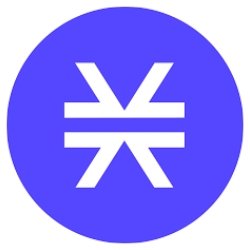
Stacks is unlocking the power of Bitcoin by enabling smart contracts, NFTs, and DeFi directly secured by Bitcoin’s proof-of-work. With the Nakamoto upgrade and the rise of Bitcoin-native assets, STX is becoming the go-to infrastructure for builders who want to deploy on the world’s most decentralized chain.
What Is Stacks?
Stacks is a Layer 1 blockchain that brings smart contracts and programmability to Bitcoin without modifying Bitcoin’s base layer. It accomplishes this through:
-
Clarity smart contracts (secure, predictable language)
-
Bitcoin anchoring — Stacks blocks settle on Bitcoin via a novel consensus mechanism (Proof-of-Transfer, or PoX)
-
Full compatibility with Bitcoin-native assets like Ordinals and BRC-20s
TL;DR: Stacks is to Bitcoin what Ethereum was to the web — a platform to build apps, marketplaces, and financial tools natively secured by BTC.
Quick Stats (As of July 2025)
| Metric | Value |
|---|---|
| Price (STX) | ~$2.75 |
| Market Cap | ~$3.2 Billion |
| Total BTC Secured | 5,100+ |
| Number of Deployed Contracts | 80,000+ |
| Daily Transactions | 250K+ |
| Nakamoto Upgrade Status | Live Q1 2025 |
| Major dApps | Alex, Bitflow, StackingDAO, Gamma |
What’s Changed for Stacks in 2025?
The Nakamoto Upgrade (Q1 2025)
This major protocol overhaul introduced:
-
Faster block finality (~10–30 seconds)
-
Full Bitcoin finality anchoring every block
-
Native Bitcoin bridging without wrapped BTC
-
Better UX for DeFi, NFTs, and BTC-secured dApps
Stacks is now more Bitcoin-aligned than ever — and doesn’t need compromises like sidechains or wrapped tokens.
1. Bitcoin DeFi Goes Mainstream
-
Lending, trading, and yield farming using BTC collateral is now live on protocols like ALEX and Bitflow
-
BTC-backed stablecoins and liquidity pools are gaining adoption
-
Trustless BTC-native swaps enabled via Clarity contracts
2. Ordinals + BRC-20 Integration
Stacks plays nicely with the Ordinals ecosystem:
-
Launchpads for inscribing and trading BTC-based NFTs
-
Metadata and trait indexing via smart contracts
-
BRC-20 utilities enhanced with on-chain logic
Why STX Matters in 2025
-
Only fully programmable L1 secured by Bitcoin
-
Unlocks DeFi for BTC’s $1.3T+ capital pool
-
Proven product-market fit in both financial and NFT use cases
-
Stacking (staking STX) pays real BTC yield — no inflation
Think of Stacks as Ethereum for Bitcoiners — without compromising decentralization or values.
Risks to Watch
-
UX friction compared to Solana/EVM chains (Clarity is a custom language)
-
Relatively smaller dev ecosystem (but growing)
-
Regulatory scrutiny may increase as Bitcoin DeFi grows
-
BTC L2 space getting competitive (e.g., BitVM, Botanix, Rootstock)
2025–2026 Outlook: The Smart Contract Layer for Bitcoin?
| Profile Type | Allocation to STX | Why |
|---|---|---|
| Bitcoin Maximalists | 10–25% | Smart contracts without leaving Bitcoin’s security |
| DeFi Builders / HODLers | 10–15% | BTC-native yield, swaps, lending |
| Undervalued Infrastructure | 5–10% | Still early in adoption curve |
Bitcoin is no longer just digital gold. With Stacks, it’s becoming programmable, composable, and unstoppable. If the next wave of DeFi and NFT growth happens on BTC rails, STX could be the most important L1 you’re not holding yet.
15. Sei (SEI):

Sei is a purpose-built Layer 1 blockchain optimized for order-book-style trading, low-latency execution, and high-throughput DeFi. In 2025, as on-chain trading scales and centralized exchanges lose trust, Sei is carving out a niche as the fastest and most specialized financial infrastructure chain.
What Is Sei?
Sei is a Layer 1 blockchain built using the Cosmos SDK, with a core focus on performance, throughput, and finality for financial applications. It uses several key innovations:
-
Parallel order execution
-
Native price oracles and order matching
-
Optimistic block processing with fast finality
-
Frontrunning-resistant architecture
Unlike general-purpose L1s, Sei is designed from the ground up to optimize for speed, consistency, and precision — ideal for trading dApps, prediction markets, sports betting, and real-time financial games.
TL;DR: Sei is what you’d get if you built a blockchain specifically for Wall Street-level trading — but open, permissionless, and on-chain.
Quick Stats (As of July 2025)
| Metric | Value |
|---|---|
| Price (SEI) | ~$0.53 |
| Market Cap | ~$1.2 Billion |
| TPS (actual) | 20,000+ |
| Block Finality | ~300ms |
| Key Protocols | Levana, Vortex, Pharaoh, Seneca |
| Dev Language | CosmWasm (Rust-based) |
| Order Book Native? | Yes |
2025 Catalysts Fueling SEI’s Growth
1. Optimized for DeFi Trading
Sei provides order-matching at the protocol level — meaning developers don’t have to build it from scratch. Combined with native price feeds and instant orderbook updates, Sei apps feel like CEXes — but live entirely on-chain.
2. Unmatched Speed & Performance
Sei boasts:
-
Sub-second finality
-
Block times under 500ms
-
MEV-resistant execution
-
Fully parallelized execution environment
This makes it ideal for:
-
High-frequency trading bots
-
On-chain derivatives
-
Real-time sports markets and prediction apps
3. Cosmos Interoperability
Built using the Cosmos SDK, Sei supports IBC (Inter-Blockchain Communication), enabling easy integration with other chains like Osmosis, Injective, Kujira, and Celestia.
Upcoming Features
-
Multi-chain liquidity aggregation
-
Real-world asset feeds (RWAs)
-
On-chain oracle coordination modules
Why SEI Deserves a Spot in Your Portfolio
-
Specialized, high-value use case (financial markets)
-
First-mover advantage in speed-focused L1s
-
Well-funded ecosystem and early-stage tokenomics
-
Dev-friendly, scalable, and growing in niche demand
Key Risks
-
Heavy competition in both DeFi (Arbitrum, Solana) and Cosmos (Injective, dYdX)
-
Narrow niche — not ideal for NFTs or general-purpose apps
-
Retail visibility is limited; low meme or cultural virality
-
Still early in ecosystem development; liquidity gaps remain
2025–2026 Outlook: The Trading Engine of Web3?
| Profile Type | Allocation to SEI | Why |
|---|---|---|
| High-Frequency Traders | 10–20% | On-chain trading bots, derivatives, order flow |
| Cosmos Ecosystem Backers | 5–15% | Interoperability + DeFi use case |
| DeFi Infrastructure Investors | 10–20% | Long-term bet on CEX-grade blockchain trading UX |
Sei isn’t trying to be everything to everyone. It’s focused, fast, and incredibly efficient — a perfect fit for traders, quant bots, and financial builders. If DeFi 3.0 demands serious speed, Sei could be the chain it runs on.
16. Fantom (FTM):

Fantom is a fast, scalable Layer 1 blockchain that’s consistently delivered real on-chain activity, grassroots developer engagement, and yield-bearing DeFi applications. In 2025, with new tokenomics, native gas monetization, and low overhead, Fantom is quietly powering a self-sustaining economy — without hype, but with results.
What Is Fantom?
Fantom is a DAG-based Layer 1 blockchain using the Lachesis consensus algorithm — a form of asynchronous Byzantine Fault Tolerance (aBFT). In simple terms, it processes transactions quickly, securely, and independently of a linear block order — allowing for:
-
Near-instant finality (~1–2 seconds)
-
Sub-$0.01 transaction fees
-
High throughput without rollups or sharding
Fantom is EVM-compatible, meaning it supports Ethereum-based smart contracts and tooling out of the box.
TL;DR: Fantom is a high-performance, low-cost smart contract platform that quietly keeps shipping and generating on-chain revenue.
Quick Stats (As of July 2025)
| Metric | Value |
|---|---|
| Price (FTM) | ~$0.63 |
| Market Cap | ~$1.7 Billion |
| TVL (Total Value Locked) | ~$820M |
| Avg. Transaction Cost | <$0.002 |
| Finality Time | ~1.2 seconds |
| Key dApps | WigoSwap, BeethovenX, Equalizer, PaintSwap |
| Dev Language | Solidity (EVM-compatible) |
2025 Growth Catalysts for Fantom
1. Revenue-Backed Tokenomics
Fantom is one of the few L1s implementing true revenue-sharing mechanics via:
-
Gas Monetization 2.0: dApps earn a portion of gas fees their users generate
-
Validator Yield: Staking FTM generates consistent returns (real fees, not emissions)
-
Deflationary Fee Burn: 10%+ of transaction fees are burned permanently
2. Solid Dev Retention
While flashy L1s chase hype, Fantom retains builders with:
-
Simplicity (EVM-native stack)
-
Low cost of deployment
-
Supportive grant and marketing ecosystem (via Fantom Foundation)
3. NFT & Culture Niche
Platforms like PaintSwap, WigoSwap, and various music-related NFT projects create a unique creator economy — especially in Southeast Asia and LATAM.
Why Fantom (FTM) Might Surprise You
-
Real on-chain activity with minimal hype
-
Net positive fee generation (one of the few L1s in the green)
-
Sustainable DeFi — less reliant on inflationary rewards
-
High community alignment; frequent governance proposals and ecosystem support
Risks to Consider
-
Not top-of-mind for new users entering crypto
-
Faces stiff competition from Solana, Avalanche, and L2s
-
Periodic liquidity droughts and volatile TVL shifts
-
Still rebuilding after post-2022 downturn and Andre Cronje departure/resurgence
2025–2026 Outlook: The DeFi Chain That Just Works?
| Profile Type | Allocation to FTM | Why |
|---|---|---|
| Yield-Seeking DeFi Users | 10–20% | Real fees, staking rewards, and low-cost DeFi |
| EVM Devs / DApp Builders | 5–10% | Smooth deployment and dApp monetization |
| Infrastructure Realists | 10–15% | Sustainable tokenomics + stable on-chain economy |
Fantom is not a hype chain — it’s a builder’s chain. With scalable infra, real token sinks, and proven uptime, FTM may quietly outperform the flashier competitors when the next real utility cycle hits.
17. Aptos (APT):

Aptos, founded by former Meta (Facebook) blockchain engineers, is a high-performance Layer 1 built using the Move programming language. With a parallel execution engine, sub-second finality, and serious enterprise partnerships, Aptos is trying to do what Solana did — but better, and with a Silicon Valley mindset. In 2025, the question is no longer whether it can scale — but whether it can lead.
What Is Aptos?
Aptos is a Layer 1 blockchain that uses a unique smart contract language called Move, originally developed for Meta’s now-defunct Diem blockchain. Aptos is built to support high-throughput dApps with:
-
Parallel transaction execution (Block-STM engine)
-
Horizontal scalability (shard-aware future roadmap)
-
Low latency and finality under 1 second
-
Rich developer tooling and modular architecture
Aptos was one of the most heavily VC-funded blockchains of 2022–2023, raising over $350M from a16z, FTX Ventures (now resolved), Multicoin, Binance Labs, and others.
TL;DR: Aptos wants to be the Web3 version of Apple — high performance, polished UX, and ready for the masses.
Quick Stats (As of July 2025)
| Metric | Value |
|---|---|
| Price (APT) | ~$9.25 |
| Market Cap | ~$3.9 Billion |
| TPS (Live Capacity) | 15,000+ |
| Finality Time | ~600ms |
| Dev Language | Move (Aptos flavor) |
| Key Ecosystem Protocols | Aries Markets, Thala, Kana Labs, Martian |
| Enterprise Partnerships | Microsoft, Google Cloud, Alibaba, SK Telecom |
What’s Driving Aptos Forward in 2025
1. Parallel Execution at Scale
Aptos’ unique Block-STM architecture allows simultaneous execution of non-conflicting transactions. This makes it ideal for:
-
Gaming
-
High-frequency DeFi
-
AI agents interacting on-chain
2. Real-World Partnerships
Aptos has signed or deployed partnerships with:
-
Microsoft (AI + identity systems)
-
Alibaba Cloud (Asia rollout)
-
SK Telecom (tokenized loyalty and fintech apps)
These integrations aren’t just whitepapers — they’re live or piloting in 2025, helping onboard traditional users to blockchain infrastructure.
3. Web3 Gaming & Commerce
Aptos is quietly becoming a Web3 gaming hub, with studios building on it for:
-
Low-latency multiplayer games
-
Tokenized in-game assets
-
Real-time AI game logic (NPCs, loot dynamics)
4. Dev UX & Modular Flexibility
Aptos offers:
-
Gas fee stability mechanisms
-
Upgradable modules
-
Developer-friendly APIs
-
Intuitive wallets and SDKs (e.g., Martian)
Why APT Might Outperform
-
Incredible technical design — arguably the fastest VM live
-
Real-world traction with global tech firms
-
Underhyped compared to the amount of dev and institutional work being done
-
Massive war chest for growth, grants, and user acquisition
Risks to Watch
-
Move adoption remains niche — most devs still prefer Solidity
-
Heavy VC allocation; concerns about token unlocks and sell pressure
-
Competing with Sui, Solana, and Celestia for mindshare and use cases
-
Network effects are building slowly; retail is largely unaware
2025–2026 Outlook: Web3’s Most Institutional-Ready Layer 1?
| Profile Type | Allocation to APT | Why |
|---|---|---|
| Enterprise-Focused Investors | 10–20% | Deep tech + strong partner integrations |
| High-Performance Chain Believers | 10–15% | Solana-like architecture with Move safety |
| Dev-Centric Portfolios | 5–10% | Tooling, infra, and innovation-first stack |
Aptos is a chain built by engineers, for scale — not hype. It may not dominate crypto Twitter, but if you’re betting on institutions, AI integrations, and developer-first design, APT deserves a serious look.
18. Pepe (PEPE):

Pepe exploded onto the scene in 2023 as a memecoin with no intrinsic utility — just pure community, humor, and virality. Yet in 2025, it’s more than just a meme: PEPE represents a shift in how value is created, sustained, and gamified in Web3. It’s market psychology, memetics, and speculation rolled into one green amphibian.
What Is Pepe?
Pepe is an ERC-20 token built on Ethereum that pays homage to the infamous Pepe the Frog meme — a staple of internet culture. It was launched with:
-
No presale
-
No dev team allocation
-
100% of the supply available to the public
Despite its lack of “utility,” PEPE quickly gained traction across trading communities, influencers, and crypto Twitter — even briefly entering the top 50 cryptocurrencies by market cap during the 2023 memecoin revival.
In 2025, PEPE is still alive and evolving, now tied into:
-
Gamified farming apps
-
Trading bots
-
Community-run dApps and NFT crossovers
TL;DR: PEPE doesn’t solve a technical problem — it solves a cultural one.
Quick Stats (As of July 2025)
| Metric | Value |
|---|---|
| Price | ~$0.00000145 |
| Market Cap | ~$610 Million |
| Max Supply | 420,690,000,000,000 PEPE |
| Circulating Supply | ~100% (fully unlocked) |
| Number of Holders | 220,000+ |
| Top 10 Wallets Hold | ~17% |
Why PEPE Still Matters in 2025
1. Meme-as-a-Market Strategy
Pepe showed that liquidity, virality, and vibes can carry a token — even in the absence of smart contracts or staking. It’s a new economic game where:
-
Memes are the message
-
Attention is capital
-
Holders are co-creators
2. Bots, Degen Culture & Mini-Games
Pepe is being integrated into:
-
Telegram-based trading bots (like Unibot, Maestro)
-
Gamified apps where users “farm” attention or engagement
-
NFT avatars and Pepe-themed DeFi protocols
3. Universal Meme Recognition
Even non-crypto users recognize Pepe. This gives it an edge in virality that other tokens lack — making it the memecoin equivalent of Bitcoin’s brand power.
4. Psychology + Simplicity = Moon
PEPE has:
-
No roadmap
-
No utility pitch
-
No dev pressure
That paradoxically makes it trustworthy in a space where overpromising is the norm. People buy it for fun — and sometimes, that’s all it takes.
Why PEPE Still Has Asymmetric Upside
-
Fully distributed supply = no team dumps
-
Viral meta is cyclical — memecoins always return during bull markets
-
Potential tie-ins with NFTs, SocialFi, or Telegram bot economies
-
Low unit price = high psychological appeal for new investors
Risks to Be Aware Of
-
No fundamentals; it’s 100% sentiment-driven
-
Rugpulls and scams often masquerade as spin-offs
-
Price can drop 80%+ in days without warning
-
No treasury or dev team = no upgrades, no recovery mechanisms
2025–2026 Outlook: Pure Speculation, Pure Culture
| Profile Type | Allocation to PEPE | Why |
|---|---|---|
| Degens & Memecoin Traders | 5–15% | High-risk, high-reward cultural exposure |
| Narrative Chasers | 5–10% | Bet on virality cycles |
| Retail Onboarding Portfolios | 1–5% | Easy entry point for new users |
PEPE may never “do” anything — and that’s precisely the point. It’s a viral asset for a meme-native generation that doesn’t want roadmaps or founders — just memes, movement, and moonshots.
19. Thorchain (RUNE):

Thorchain is a cross-chain liquidity protocol that enables native asset swaps — like BTC to ETH — without wrapping, bridging, or trusting a third party. In 2025, Thorchain is not only live and working — it’s generating fees, expanding to more chains, and leading the charge for fully decentralized interoperability.
What Is Thorchain?
Thorchain is a decentralized liquidity protocol that allows users to swap native Layer 1 assets (e.g. Bitcoin, Ethereum, Litecoin, Dogecoin) directly across chains, without wrapping or centralized bridges.
It achieves this through:
-
Liquidity pools composed of native assets
-
Automated market makers (AMMs) that price and route trades
-
Bifröst bridges and vaults managed by node operators
-
RUNE as the settlement asset in every liquidity pair
TL;DR: Thorchain does what no bridge can — true cross-chain swaps with full custody of your assets.
Quick Stats (As of July 2025)
| Metric | Value |
|---|---|
| Price (RUNE) | ~$5.20 |
| Market Cap | ~$1.75 Billion |
| Native Chains Supported | 12+ (BTC, ETH, BNB, AVAX, ATOM, DOGE…) |
| Daily Swap Volume | $35M+ |
| Protocol Revenue (Annualized) | $45M+ |
| Key Interfaces | THORSwap, Asgardex, Maya, XDEFI |
2025 Highlights & Innovations
1. True Cross-Chain, No Wrapping
Users can swap BTC directly to ETH, or DOGE to AVAX, or any supported pair — with:
-
No custodians
-
No wrapped tokens
-
No bridge risks
2. Yield from Real Fees
Liquidity providers (LPs) earn actual swap fees paid by users — not emissions. RUNE is used to bond and secure these pools.
-
Yield is sustainable
-
Impermanent loss is minimized through continuous rebalancing
-
Protocol revenue is fully on-chain and growing
3. Synths & Streaming Swaps
Thorchain now supports:
-
Synthetic assets for faster swaps with lower slippage
-
Streaming swaps that allow for dollar-cost averaging within a single TX
4. Wallet + App Ecosystem
-
THORWallet and XDEFI offer full non-custodial interfaces
-
Maya Protocol (a fork) and others are building in parallel
-
THORFi now includes native lending and borrowing
Why RUNE Is a Solid Mid-Cap Infrastructure Play
-
True cross-chain utility with real daily usage
-
Aligned with decentralization ethos (no wrapped assets or bridges)
-
One of the only protocols with sustainable protocol revenue
-
Expanding to additional L1s and building a “cross-chain stablecoin” narrative
Risks to Watch
-
Complex tech; past vulnerabilities have led to exploits (mostly patched)
-
Liquidity fragmentation among many interfaces and forks
-
Limited institutional interest due to non-EVM design
-
LP risks (slippage, impermanent loss) require education
2025–2026 Outlook: The Interchain DEX That Actually Works
| Profile Type | Allocation to RUNE | Why |
|---|---|---|
| Cross-Chain Infrastructure Backers | 10–20% | Real volume, real use case |
| DeFi Power Users | 5–15% | Native yield and cross-chain execution |
| Decentralization Maxis | 10–20% | No bridges, no wrappers, no custodians |
Thorchain quietly solves one of crypto’s biggest UX problems — safely moving between chains. With working infrastructure, strong tokenomics, and expanding integrations, RUNE remains one of the most underrated core layer plays in all of DeFi.
20. Ethena (ENA):

Ethena is a groundbreaking protocol that powers the world’s first fully decentralized, crypto-native synthetic dollar — USDe — backed not by fiat, but by delta-neutral crypto strategies. In 2025, Ethena is not only a staple in DeFi portfolios, but also part of a broader AI-enabled automation trend that’s pushing DeFi into its next evolutionary phase.
What Is Ethena?
Ethena is a synthetic stablecoin protocol designed to create and maintain USDe — a “synthetic dollar” backed by delta-neutral positions in Ethereum and other crypto assets. It’s built entirely on-chain, with no reliance on centralized banks, and aims to replace fiat-backed stables like USDT or USDC.
Key innovations include:
-
Delta-neutral strategies: Long ETH spot + short ETH perps = stable price
-
Real yield: Generated from funding rates on perps markets
-
Smart hedging and automated rebalancing
-
ENA as the governance and value capture token
TL;DR: Ethena’s USDe is not backed by cash — it’s backed by math.
Quick Stats (As of July 2025)
| Metric | Value |
|---|---|
| Price (ENA) | ~$0.89 |
| Market Cap (ENA) | ~$1.05 Billion |
| Circulating USDe | $2.7 Billion |
| Backing Assets | ETH, stETH, BTC, Liquid Staking Tokens |
| Yield (APY) on USDe | 7–14% (variable, from funding markets) |
| Top Integrations | Curve, Pendle, Gearbox, Morpho, Frax |
What Makes Ethena a DeFi Game-Changer
1. USDe: A Truly Crypto-Native Stablecoin
USDe is:
-
Not reliant on banks or fiat reserves
-
Always on-chain, composable in DeFi
-
Censorship-resistant and global
In a world where USDC is freezing wallets and regulators are circling centralized stables, Ethena offers freedom with a synthetic approach.
2. Yield from Market Dynamics
Instead of offering unsustainable emissions, USDe earns real yield from:
-
Shorting perps (funding rates from CEXs like Binance, OKX)
-
Hedging via stETH and LRTs (liquid restaking tokens)
-
Yield-bearing integrations with protocols like Pendle and Morpho
3. AI-Enhanced Automation
In 2025, Ethena has rolled out AI-enhanced rebalancing strategies and portfolio allocation, adjusting collateral and hedge ratios based on market volatility in real time.
-
AI ensures capital efficiency
-
Reduces liquidation risks
-
Increases composability with DeFi protocols
4. Modular DeFi Legos
-
Use USDe as collateral across DeFi
-
Stake ENA for governance and protocol yield
-
Plug into LRT protocols, real yield vaults, and advanced derivatives
Why ENA Is a High-Potential Governance Token
-
Captures value from protocol fees and yield spreads
-
Governance over rebalancing strategies, collateral sets, and reward schedules
-
Strong backing from leading VCs, quants, and yield protocols
-
Still early in its lifecycle with low retail penetration
Risks to Consider
-
Dependence on perp markets: Yield relies on positive funding, which can reverse
-
Complex mechanics: Not always easy to understand for casual users
-
AI systems are powerful but introduce opaque behavior
-
Regulatory scrutiny of algorithmic stablecoins (e.g., Terra PTSD still lingers)
2025–2026 Outlook: The “BlackRock of On-Chain Dollars”?
| Profile Type | Allocation to ENA | Why |
|---|---|---|
| DeFi Yield Seekers | 10–20% | Real-yield dollar exposure with flexibility |
| Stablecoin Maximalists | 5–15% | Bet against fiat-reliant stablecoins |
| AI + Crypto Infrastructure | 10–15% | Smart automation and financial infrastructure |
Ethena is one of the few protocols where innovation, revenue, and adoption intersect meaningfully. If USDe continues to grow — and if AI-assisted asset management becomes mainstream — ENA could be the king of DeFi’s next generation.
3. Emerging Contenders (2025 Underdogs That Could 10x)
What’s Bubbling Under the Radar?
Projects With Low Market Cap but High Potential
In every cycle, the true outliers emerge from the shadows — projects with small caps, breakout narratives, and fierce community conviction. These are the asymmetric plays that quietly position themselves to outperform when macro tailwinds align.
Here are 8 high-conviction underdogs that could surprise the market in 2025–2026:
1. Karate Combat (Karate)
Real-World Sports Meets Tokenized Fandom
-
The world’s first on-chain combat league, combining martial arts, DeFi-style gamification, and fan-owned fighter economics.
-
Users stake on fighters, influence matchups, and earn governance rewards.
-
Broadcast partnerships, YouTube virality, and real athlete buy-in.
𝗪𝗵𝘆 𝗶𝘁 𝗰𝗼𝘂𝗹𝗱 𝟭𝟬𝗫: It’s the UFC of crypto — and it actually works.
2. Shrapnel (Shrap)
AAA Gaming Meets Asset Ownership
-
Built on an Avalanche subnet with real game engines (Unreal Engine 5).
-
Players own and trade weapons, skins, and even maps as NFTs.
-
Creator economy baked into gameplay — think Roblox for shooters.
𝗪𝗵𝘆 𝗶𝘁 𝗰𝗼𝘂𝗹𝗱 𝟭𝟬𝗫: First AAA crypto FPS with full economic rails.
3. Aevo (Aevo)
DeFi Derivatives with CEX Speed
-
Order book perps, options, and vaults under one clean UI.
-
Built by Ribbon Finance team; backed by Paradigm.
-
Blazing-fast execution; permissionless trading strategies.
𝗪𝗵𝘆 𝗶𝘁 𝗰𝗼𝘂𝗹𝗱 𝟭𝟬𝗫: DeFi options are wide open — Aevo is already leading.
4. Kujira (Kuji)
Sovereign DeFi on Cosmos
-
Born from Terra’s ashes, now a revenue-sharing powerhouse with real yield.
-
Offers money markets, liquidation engines, and a DEX — all under one token.
-
Fee revenue paid in multiple tokens, not inflation.
𝗪𝗵𝘆 𝗶𝘁 𝗰𝗼𝘂𝗹𝗱 𝟭𝟬𝗫: Built, shipped, and sustained. And it’s still undervalued.
5. Talisman (Tal)
Multichain Wallet Meets Web3 Identity
-
UX-focused wallet for Ethereum, Polkadot, and parachains.
-
Enables staking, governance, and human-readable naming systems.
-
Built-in ENS-style identity layer and DeFi dashboard.
𝗪𝗵𝘆 𝗶𝘁 𝗰𝗼𝘂𝗹𝗱 𝟭𝟬𝗫: Where DeFi, identity, and cross-chain UX converge.
6. Saga (Saga)
App-Chains-as-a-Service
-
Enables developers to launch their own chainlets — single-purpose blockchains.
-
Modular stack integrated with Celestia, IBC, and Ethereum tooling.
-
Fully scalable with seamless horizontal deployment.
𝗪𝗵𝘆 𝗶𝘁 𝗰𝗼𝘂𝗹𝗱 𝟭𝟬𝗫: Rollup-as-a-Service is big — Saga productizes it with dev-first UX.
7. Manta (Manta)
Privacy Layer Meets ZK L2 Scaling
-
ZK-native Ethereum L2 optimized for privacy-preserving smart contracts.
-
Offers identity-verified private assets and on-chain compliance rails.
-
Backed by Binance Labs, Polychain, and Jump.
𝗪𝗵𝘆 𝗶𝘁 𝗰𝗼𝘂𝗹𝗱 𝟭𝟬𝗫: ZK + privacy + compliance is an underpriced mega-narrative.
8. Modo (Modo)
SocialOS for Web3 Communities
-
Web3-native social network stack — posts, payments, and NFTs built into every feed.
-
Embedded DAOs, governance, and micro-economies for creators.
-
Still early, but developer and creator buzz is growing.
𝗪𝗵𝘆 𝗶𝘁 𝗰𝗼𝘂𝗹𝗱 𝟭𝟬𝗫: If Farcaster was v1, Modo could be v3.
4: Market Narratives to Watch in 2025–2026
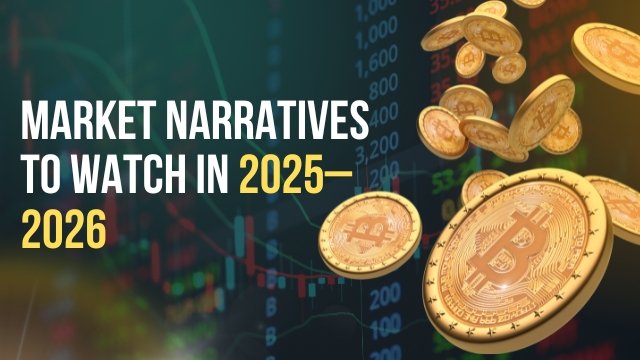
Macro Trends Driving the Next Wave of Crypto Growth
Crypto is no longer just about blockchains and coins — it’s a convergence of global finance, decentralized infrastructure, AI, real-world economies, and internet culture. In this section, we break down the strongest investment-grade narratives that are shaping capital flows, protocol design, and user behavior across the ecosystem.
Each of these themes represents a long-term thesis — and each one is already driving major attention, development, and funding.
1. AI + Crypto Integration
The Convergence of Autonomous Intelligence and Decentralized Execution
-
Smart agents that trade, borrow, and govern autonomously on-chain
-
AI inference jobs and training tasks distributed across GPU protocols like Render (RNDR), Akash, and Bittensor
-
AI-powered DeFi strategies, prediction models, and on-chain bots
-
AI × zkML (zero-knowledge machine learning) to verify model outputs without revealing inputs
2025 Leaders: Render (RNDR), Injective (INJ), Bittensor (TAO), Morpheus, Gensyn
Why It Matters: AI needs trustless compute. Crypto provides the execution layer. The fusion creates markets where AI agents are economic actors.
2. Real-World Assets (RWA)
Bridging Trillions from Traditional Finance to DeFi
-
Tokenized treasuries, bonds, real estate, and equities hitting the blockchain
-
Stablecoin growth shifting to yield-bearing assets (sDAI, TBY, USDe)
-
Permissioned DeFi protocols gaining institutional approval
2025 Leaders: Chainlink (LINK), Avalanche (AVAX), Ethena (ENA), Ondo Finance, Frax, Maple
Why It Matters: RWAs bring real cash flows to crypto. It’s the clearest path to onboarding institutional capital without sacrificing decentralization.
3. Modular Blockchains
Unbundling the Monolith for Infinite Scalability
-
Separation of execution, settlement, consensus, and data availability
-
Rollups launching on Celestia, Avail, and EigenDA instead of Ethereum
-
Rollup-as-a-Service (RaaS) enabling one-chain-per-app deployment
-
L2 wars replaced by modular middleware coordination
2025 Leaders: Celestia (TIA), Saga (SAGA), Eclipse, Dymension, Avail
Why It Matters: Modular design is like microservices for crypto. It enables custom performance, compliance, and UX — without reinventing the wheel every time.
4. Restaking Economy (EigenLayer + Beyond)
Recycling ETH’s Trust to Power New Protocols
-
ETH restakers lend economic security to oracles, bridges, AI verifiers, and more
-
Re-staking rewards via EigenLayer and Actively Validated Services (AVSs)
-
Emergence of a “shared security” marketplace — security as a primitive
2025 Leaders: EigenLayer (AVS ecosystem), EtherFi, Renzo, LRT tokens, Obol, Symbiotic
Why It Matters: Restaking monetizes trust. It’s the infrastructure layer behind many next-gen protocols — without issuing new tokens or bootstrapping new validators.
5. Privacy Coins Comeback
Selective Disclosure in a World of Surveillance
-
ZK-based privacy layers that let users reveal “only what’s needed”
-
Compliance-ready private DeFi — e.g. KYC-gated pools with encrypted balances
-
Decentralized ID (DID) combined with privacy-preserving verification
-
Blend of opt-in transparency and data minimization
2025 Leaders: Manta (MANTA), Aztec, Secret (SCRT), Aleo, Namada
Why It Matters: Privacy is no longer binary (on/off). The new privacy tech stack lets you comply without giving up sovereignty.
6. Meme Coins With Real Utility
Where Community, Speculation & Utility Intersect
-
Tokens born as memes but evolving into platforms: NFTs, bots, staking, gaming
-
Cult communities turning into DAOs, launchpads, and fundraisers
-
Integration into Telegram mini-apps, DeFi tools, and tipping systems
2025 Leaders: Pepe (PEPE), Bonk (BONK), WIF, TapSwap, Notcoin
Why It Matters: Memes are distribution. Utility turns volatility into stickiness — creating cultural gravity around assets once considered jokes.
5: How to Build a Diversified Crypto Portfolio in 2025
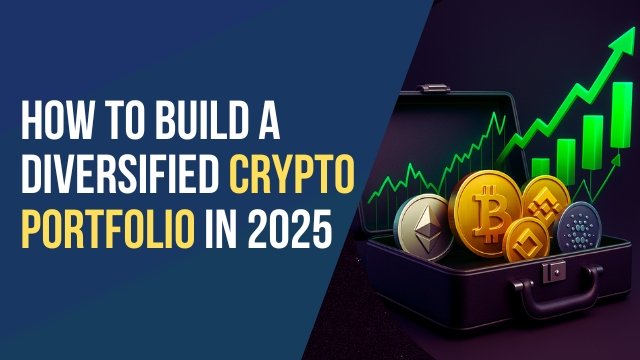
Strategies for Beginners vs. Advanced Traders | Understanding Layers, Narratives, and Yield.
In a rapidly evolving market like crypto, proper portfolio construction is more than just buying top coins — it’s about understanding volatility, liquidity, conviction, and your own risk profile. With new narratives (AI, RWAs, Modular Chains) emerging alongside old blue-chips (BTC, ETH, SOL), a smart portfolio balances stability with asymmetric potential.
Below, we break down strategies tailored to both beginners and advanced traders — along with tips on weighting L1s, L2s, memecoins, and yield-generating assets.
Strategies for Beginners vs. Advanced Traders
For Beginners:
-
Stick to high-liquidity, high-conviction assets like BTC, ETH, SOL
-
Keep allocations simple: 60–70% blue chips, 20–30% mid-caps, 5–10% wild cards
-
Don’t chase hype — follow narratives with strong fundamentals and real usage
-
Focus on long-term holding (12–24+ months) over short-term flipping
-
Use DCA (Dollar Cost Averaging) to reduce entry timing risk
Sample Beginner Portfolio:
| Category | Allocation | Examples |
|---|---|---|
| Core Assets | 40% | BTC, ETH |
| Growth L1s | 20% | SOL, AVAX, SUI, APTOS |
| Layer 2s | 15% | ARB, OP, BASE |
| DeFi Infra | 10% | LINK, INJ, TIA |
| Wild Cards | 10% | PEPE, RNDR, MANTA |
| Stablecoins | 5% | USDC, USDe (for entry + yield) |
For Advanced Traders:
-
Actively rotate between narratives (AI, Modular, RWAs, Memes)
-
Use cross-chain liquidity, LSTs, and staking derivatives
-
Incorporate farming, governance participation, and retroactive airdrop hunting
-
Hedge volatility with stablecoin vaults, DEX options, or liquid restaking strategies
-
Leverage bots, analytics dashboards, and Telegram integrations
Sample Advanced Portfolio Strategy:
| Category | Allocation | Tactics & Assets |
|---|---|---|
| ETH & Liquid Staking | 25% | stETH, eETH, sfrxETH, EigenLayer |
| L1 Rotation | 20% | Rotate SOL, APT, SUI, AVAX based on ecosystem TVL |
| AI/Narrative | 15% | RNDR, TAO, Gensyn, Morpheus, Injective |
| Modular & Infra | 10% | Celestia, Saga, Avail, EigenLayer, LRT tokens |
| DeFi Yield | 10% | Pendle, Ethena, Morpho, GMX, Aevo |
| Memecoin Index | 10% | PEPE, WIF, BONK, TapSwap (with stop losses) |
| Stables / Dry Powder | 10% | USDC, USDe, TBY (for re-entry and farming) |
Layer 1s vs. Layer 2s vs. AI Tokens vs. Memecoins
Understand the role each narrative plays in your portfolio:
-
Layer 1s (BTC, ETH, SOL, AVAX, APT): Your structural base. Network security, asset collateral, adoption bets.
-
Layer 2s (ARB, OP, BASE): Ethereum scaling exposure. High upside, moderate volatility.
-
AI Tokens (RNDR, TAO, INJ): Narrative-driven growth with real-world demand.
-
Memecoins (PEPE, WIF, BONK): Pure sentiment plays. High risk, potential parabolic upside.
-
Modular / Infra (TIA, SAGA, EigenLayer): Long-term picks for scalability and developer demand.
Tip: Match conviction with allocation. Don’t go 20% into a memecoin unless you’d be okay losing most of it.
Stablecoins, Yield, and DeFi Considerations
Your cash and yield stack matters just as much as your token bets:
-
Use stablecoins like USDC, USDe, TBY or LUSD for:
-
Farming low-risk DeFi vaults (e.g. Pendle, Curve, Morpho)
-
Entry capital for DCA on dips
-
LP positions or collateral for borrowing
-
-
Explore DeFi protocols that offer real yield:
-
Liquid Restaking (EtherFi, Renzo, EigenLayer)
-
Perp funding plays (Ethena USDe)
-
Real-world DeFi (Ondo, Centrifuge, Frax)
-
-
Avoid:
-
Obscure tokens with unsustainable APYs
-
Single-token farms with no TVL or history
-
Illiquid LP pairs with large slippage
-
Final Thoughts on Portfolio Construction:
-
Balance is key: long-term conviction + narrative rotation + dry powder
-
Don’t over-leverage or chase pumps; compounding beats gambling
-
Follow on-chain metrics (TVL, daily active users, treasury health)
-
Use tracking tools like DeFiLlama, CoinGecko watchlists, Zapper, and Nansen to monitor your positions
6. Final Thoughts
The Golden Era of Crypto May Just Be Starting
After a turbulent but transformative few years, the crypto markets in 2025 are maturing — and thriving. We’re no longer betting on speculative concepts or vaporware; we’re investing in real infrastructure, global financial primitives, cross-chain execution, and cultural economies powered by blockchain rails. Whether it’s Bitcoin’s institutional integration, Ethereum’s Layer 2 dominance, AI agents trading autonomously, or tokenized assets crossing into real estate, the decentralized world is not just coming — it’s here.
But it’s still early.
The winners of the next cycle won’t just be the loudest or fastest movers. They’ll be the protocols solving meaningful problems, aligning with structural narratives, and quietly compounding network effects while others chase noise. You don’t have to catch every trend — but you do need a strategy.
Below are sample portfolio breakdowns based on three risk profiles to help you position accordingly:
Final Picks Based on Your Risk Appetite (Conservative / Balanced / Aggressive Portfolio Breakdown)
Conservative Portfolio (Low Risk, Long-Term Conviction)
-
40% Bitcoin (BTC)
-
30% Ethereum (ETH)
-
10% Stablecoins (USDC, USDe) for DCA and farming
-
10% Chainlink (LINK) or Avalanche (AVAX) — real-world infrastructure
-
10% DeFi protocols with yield (Ethena, Pendle)
Goal: Capital preservation + slow growth with low downside volatility
Balanced Portfolio (Moderate Risk, Thematic Exposure)
-
30% BTC / ETH combo
-
20% Growth Layer 1s (SOL, SUI, APTOS)
-
15% Layer 2s (ARB, OP, BASE)
-
10% AI + Modular Plays (RNDR, INJ, TIA)
-
10% Real Yield + Stablecoins (USDe, TBY, Ethena)
-
10% Wildcard / Narratives (MANTA, PEPE, KUJI, AEVO)
-
5% Underdog Bet (KARATE, SHRAP, MODO)
Goal: Capture narrative upside with diversification + passive income
Aggressive Portfolio (High Risk, High Reward)
-
20% AI + Restaking Narrative (RNDR, INJ, EigenLayer AVSs)
-
15% Emerging Modular & L2 Infra (SAGA, Celestia, Avail)
-
15% Memecoins with momentum (PEPE, WIF, BONK, NOT)
-
10% DeFi yield + options (Aevo, Pendle, Ethena)
-
10% Gaming, Social, Culture Coins (SHRAP, KARATE, MODO)
-
10% Layer 1 rotation (SOL, AVAX, SUI)
-
10% USDe or stables for liquidity
-
10% Low-cap Wildcards & Airdrop Farming
Goal: Maximize upside in frontier sectors; reallocate during narrative shifts
2025–2026 could be the most important cycle for crypto yet — and you’re early. Whether you’re a long-term believer or just exploring this space, having a framework, a thesis, and the right allocation strategy can mean the difference between chasing trends and catching exponential value.
Stay informed. Stay disciplined. Stay sovereign.
Would you like a printable PDF of the full guide? Or visual infographics for each portfolio type and narrative stack?
Frequently Asked Questions About Top 20 Cryptocurrencies to Invest In for 2025 & 2026
Q1. Is It Too Late to Invest in Bitcoin or Ethereum?
Answer: Not at all. Despite reaching new all-time highs and increased institutional attention, Bitcoin and Ethereum remain foundational pillars of the crypto economy. Bitcoin continues to evolve as a globally accepted store of value — “digital gold” — while Ethereum has firmly positioned itself as the settlement layer for decentralized applications, Layer 2s, real-world assets (RWAs), and the broader DeFi ecosystem. In 2025, the total global crypto adoption rate is still under 5%, which means we’re early in the adoption curve. While the chance of a 100x return may no longer apply to BTC or ETH, they remain among the safest and most asymmetric long-term bets in digital finance.
Q2. How Much Should I Invest in Crypto in 2025?
Answer: The answer depends heavily on your financial goals, risk tolerance, and time horizon. For conservative investors, allocating 1–5% of your overall portfolio to major assets like BTC, ETH, and high-yield stablecoin protocols offers exposure without excessive risk. Balanced investors might consider a 5–15% allocation across a mix of blue-chip L1s, Layer 2s, and yield-bearing assets. Aggressive investors or crypto-native traders may go beyond 20–30% if they have deep conviction and understand market cycles. Regardless of your risk profile, the golden rule holds: never invest more than you can afford — emotionally or financially — to lose. Start with conviction, build with patience, and don’t chase hype blindly.
Q3. What’s the Safest Way to Store These Assets?
Answer: Crypto security is critical, especially as scams, phishing attacks, and centralized exchange risks persist in 2025. The safest approach is to use hardware wallets like Ledger, Trezor, or Keystone for long-term storage — these are physical devices that store your private keys offline. For everyday use or DeFi participation, pair these hardware wallets with smart contract wallets like Safe (formerly Gnosis), Argent, or Rabby, which offer programmable recovery options and multisig protection. If you’re an active trader, you may need hot wallets like MetaMask, Rabby, or XDEFI — but always use them with caution and limit balances. Centralized exchanges like Binance or Coinbase should only be used for trading, not custody. For maximum safety, consider using a multi-wallet setup: cold storage for long-term assets, a separate wallet for farming and DeFi, and an isolated wallet for speculative or meme coin plays.
Q4. Can You Still 10x in This Market?
Answer: Yes — but you need to be selective, strategic, and early. The days of blind meme coin rallies are giving way to value-based growth driven by real adoption, protocol revenue, and strong narratives. Top-tier assets like Bitcoin or Ethereum are unlikely to 10x from current levels in a single cycle, but they provide long-term asymmetric upside with lower risk. The real 10x opportunities today lie in mid-caps (like RUNE, INJ, or TIA) that are building critical infrastructure, as well as emerging micro-cap projects tied to breakout narratives such as AI, restaking, or modular blockchains. Timing matters more than ever: accumulate during quiet periods, follow ecosystem development, and align your entry with narrative momentum. Use conviction, not FOMO — and size your bets with care.


